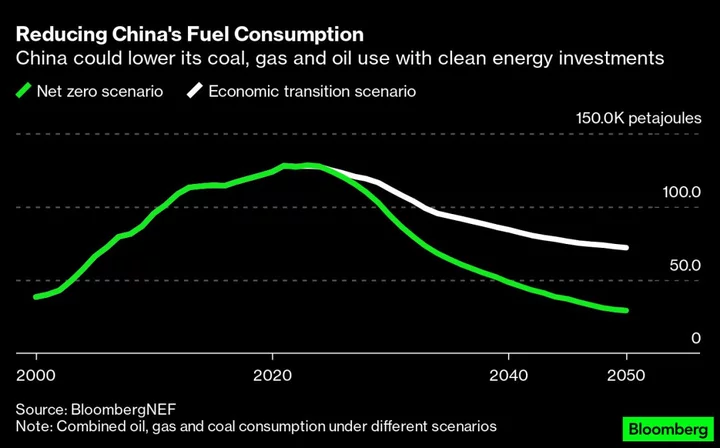China, the world’s biggest greenhouse gas emitter, can beat its existing climate targets and hit net zero by 2050 if the nation lifts investment in decarbonization to about $38 trillion.
That would allow the world’s No. 2 economy to accelerate the transition of its power sector, the largest source of carbon emissions, BloombergNEF said Tuesday in its New Energy Outlook: China report. Measures include adding more energy storage, nuclear generation and carbon capture technology while extending its world-leading deployment of solar and wind.
To be on track to zero out emissions by mid-century, China will need to roughly triple its energy transition investment to an annual average of almost $1.7 trillion in the later years of this decade. China spent $550 billion in 2022 and accounted for about half the global total, according to BNEF.
“China already leads the world in manufacturing and deployment of renewables, batteries and electric vehicles,” said Nannan Kou, BNEF’s head of China research. “China now needs to accelerate support for early-stage technologies such as clean hydrogen, CCS and advanced nuclear to ensure these technologies can be commercialized in a timely manner.”
The nation’s rush to ramp up coal production after two consecutive summers of disruptions to power supplies had dampened expectations that China could surpass President Xi Jinping’s targets for emissions to peak before 2030 and to achieve carbon neutrality by 2060.
While China’s emissions grew 4% in the first quarter and are likely to touch a record this year, the rapid deployment of clean energy means that trend will soon begin to reverse, the Centre for Research on Energy and Clean Air said this month. Though the country’s energy sector continues to invest in new coal mines and power plants, those are now largely intended to act as a backup fuel source as wind and solar power become dominant.
Under a scenario in which China hits net zero by 2050, coal consumption should peak this year, oil in 2024 and gas in 2029, BNEF said in its report. Oil use could be 60% below 2022 levels in 2050 and gas consumption about 73% lower, the report said.
To meet a 2050 net zero target, China will need to pursue electricity market reforms and continue expansion of its grid to increase the share of renewables in its electricity supply, according to BNEF. Grid spending would need to rise 81% to around $136 billion a year.
There’s also a need for additional support for technologies aimed at helping heavy polluting industries to curb emissions, including the use of hydrogen, carbon capture and nuclear, BNEF said.
--With assistance from Dan Murtaugh.









